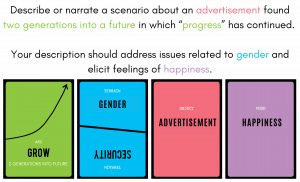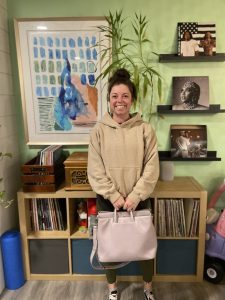
In a land far far away, or two generations into the future on earth, an advertisement is unearthed from a University time capsule that was created to be opened 70 years later as a comparative cultures project. The time capsule was dug up as a part of a history project for a University course comparing pop culture in 2019 to 2089. The world has progressed in the sense that transparency and acceptance have come to the forefront of global values. Companies and government agencies have shifted from profit to transparent marketing and sustainable practices (although this may seem impossible this is my dream speculative future, so here we go).
The current year is 2086 and the time capsule is from 2019. Slowly pieces are extracted from the time capsule:

- An iPhone 11 with the following apps downloaded
- Messenger
- TikTok
- Snapchat
- Spotify
- A USB that has the following downloaded media files on it
- TV SERIES
- Final season of Game of Thrones (although for some reason the file wouldn’t open.. oh well, nothing lost there)
- Euphoria
- The Mandalorian
- Sex Education
- Top Boy
- Stranger Things
- Top Boy
- MOVIES
- A Star is Born
- Avengers: Endgame
- The Gentlemen
- Us
- Someone Great (Lizzo’s song “Truth Hurts” in this movie made her blow up this year!)
- ALBUMS
- Norman F*cking Rockwell! – Lana Del Rey
- While We Wait – Kehlani
- Heard it in a Past Life – Maggie Rogers
- Ginger – Brockhampton
- Fine Line – Harry Styles
- Pop Culture Highlights
- Laverne Cox’s Smirnoff Advertisement
- Taylor Swift’s music video with Todrick Hall, cast of Queer eye, Billy Porter, Tatiana, Trinity K Bonet (among MANY others).
- TV SERIES
- Apple AirPods
- Airfryer (because what would a time capsule be without the newest kitchen gadget obsession included)
- Instax Mini Camera
As the students go through the contents of the capsule, they laughed and analyze how different pop culture was in 2019; how much transition was occurring and how people experiencing systemic oppressions were still fighting to be seen and acknowledged.
The professor asked the students to choose one artifact to focus on for a class discussion. The students unanimously chose the advertisement by Laverne Cox as it focused on the fight that the 2SLGBTQIA+ community was in with society and government. The advertisement from Laverne Cox stood out as something that was a huge step towards equal representation in media. Not only is Laverne Cox a trans woman but she is a black trans woman, and these intersecting qualities were still at the forefront of oppression in the year 2019.
The students projected the advertisement as a hologram in the middle of their talking circle and took notes on topics related gender in 2019 they would like to compare and contrast with their current society in 2089. The first student to share said the following:
“I find it interesting how much focus was put on gender identity. Why did society care so much about this? It seems like a lot of time was wasted trying to oppress people based on something that didn’t impact anyone other than them. And gender expression also encouraged people to be themselves, how is that bad!? Laverne Cox is absolutely stunning and such an icon. She is certainly an icon to this date. Not only was she one of the first trans women in mainstream media but she was in a commercial with a cis white man. I appreciate Laverne’s fight and can’t even imagine what she went through in the spot light as a trans woman. It makes me happy to think that people were so willing to fight so that we could live in the society we have today.”
Students nodded and the next student chimed in with their perspective:
“I totally agree. Women like Laverne made the world we have today possible. Not only is gender identity encourages, it isn’t really a big deal at all! We don’t have any laws prohibiting self expression and people just go about their days. Could you imagine caring so much about how someone presents themselves in society that you try and prevent it from happening? Think about the law that passed in Tennessee in 2023 that put age restrictions on drag performances because they were too sexual (Mizelle, 2023)? I’m not sure how drag queens reading to children fall under this? Like…. how was drag queen story time considered bad but Grand Theft Auto wasn’t? These people were confusing. These people seemed so backwards. It makes me so happy to think that I live in the time that I do now, where the spotlight is not put on gender and instead focuses on what you stand for. It’s hard to believe a commercial today saying ‘it’s for everyone no matter who you are’ because that’s just generally implied. Sucks that they had to say things like that back then because so many people wanted others excluded.”
Students chatted amongst themselves and agreed that the time capsule activity was a positive experience. Not only were they able to reflect on the affordances they have in their modern society but they were able to give thanks to those who made it possible.
In this speculative future, western society has moved past its obsession with controlling others self expression and allowed for a much more colourful world to flourish.
References
Situation Lab. (n.d.). The Thing From The Future. Situation Lab. https://situationlab.org/project/the-thing-from-the-future
Marketing The Rainbow. (2021).Smirnoff – welcome home (Laverne Cox WorldPride 2019) [Video]. Youtube. https://www.youtube.com/watch?v=A3z7WDUrM5I
Mizelle, S. (2023, March 3). Tennessee becomes first state in 2023 to restrict drag performances. CNN. https://www.cnn.com/2023/03/02/politics/tennessee-ban-drag-show-performances-governor/index.html
Raz, D. (2019). Smirnoff | Ted Danson, Laverne Cox [Video]. Youtube. https://www.youtube.com/watch?v=zlh_YOUVS0g
Swift, T. (2019). Taylor Swift – You need to calm down [Video]. Youtube. https://www.youtube.com/watch?v=Dkk9gvTmCXY




 :
: 







 .
. 













 .
.






 .
.





 .
.







 .
.

 .
.








 .
.
